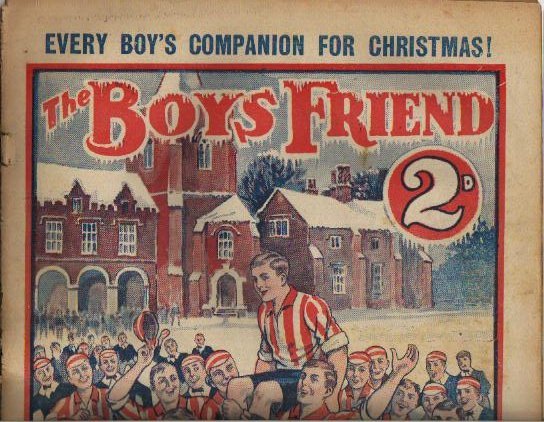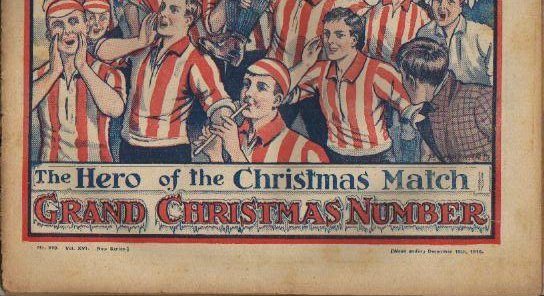| bc | THE
BOYS' FRIEND Storypaper, Published by the Amalgamated Press, London, England Home of Charles Hamilton's third great school - Rookwood Writing as "Owen Conquest". Finalised 24th May, 2015. |
 |
| bc | The Boys' Friend 1895 to 1927, Rookwood, Owen Conquest, Charles Hamilton, Jimmy Silver, The Terrible Three and Tubby Muffin. |
| bc | THE
BOYS' FRIEND Storypaper, Published by the Amalgamated Press, London, England Home of Charles Hamilton's third great school - Rookwood Writing as "Owen Conquest". Finalised 24th May, 2015. |
 |
| bc |   |
| bc | What better way to introduce THE BOYS' FRIEND than
with a CHRISTMAS NUMBER for 1916. To be precise, this was
issue #810, Vol. XVI (new series), dated December 16,
1916. 28 pages, tabloid size. Cost - 2d. Bill Gander's STORY PAPER COLLECTOR, #1, Vol.1, Jan-March, 1941, provided most of the information for this page. TBF first appeared in 1895, almost 110 years ago, the first issue being dated January 29, 1895. For its entire run a uniform size of 14&1/2 x 11 inches was maintained. This approximates what today is termed "tabloid" size. Apart from a period during the Boer War years of 1899 when a yellow-tinted stock was used, TBF regularly appeared on a lightish-green paper and was commonly known among first generation collectors as "the green'un". Special issues as per the Christmas Number above appeared on creamy stock. The first issue, at 16 pages, was a "double number"; early issues consisted of two sheets or 8 pages. At one halfpenny, it gave good value and would have occupied the readers' attention for many hours. Bill Gander in the article above mentions that the first issue contained a denunciation of the so-called "Penny Dreadful", or "blood", despite the fact that many of the contributors also wrote for those possibly inferior publications. To quote Bill, "...maybe their writings became purified when Mr Edwards used them." Hamilton Edwards was TBF editor. The next special issue, a Christmas Number, was #47, and many more would follow. Some would be "double numbers" although this wasn't always the case with special issues. With the arrival of the Boer War, Britain soon found itself in the grip of "war fever", and thus began the practice of "war issues" from #250 - and regular "double numbers" for the period thereof. (For Australian magazine readers, "war issues" appeared during WW1 for often lengthy periods. The Sydney Mail appeared during 1915-16 with "war issue" in prominent lettering on the covers.) Numerous prominent writers contributed to TBF, often uncredited or via pseudonyms, and many remain to be identified. Characters also appeared from other AP publications, "Nelson Lee" for example, back in the days when he was primarily a detective rather than a headmaster/'tec at St. Frank's. With the arrival of #332, June 8, 1901, the cover price was doubled to a penny (1d) but the page size also doubled to 16 pages. Still a bargain in anyone's eyes. According to Bill Gander, the old numbering continued alongside the new numbering for the first year, a peculiarity which will cause problems with Steve's SPI, perhaps. Yet another peculiarity arrived with #41 New Series, March 22, 1902; a special Boat-Race number printed in blue ink! Around this period the other two mighty AP tabloid papers appeared; "The Boys' Realm", in 1902 and "The Boys' Herald" a year later. Although both papers began with a similar content to TBF, the former would later take on sport as its theme while the later would become a hobby interest paper. Hamilton Edwards ran all three papers until around 1912 when he was appointed a director on the AP board. Both "The Boys' Realm" and "The Boys' Herald" expired soon after, while "Dreadnought" appeared, sinking on its own accord during the war. Excuse the pun. H.A. Hinton, the brilliant editor of the early Magnet, Gem and Penny Popular took TBF on in early 1915, somehow convincing Charles Hamilton to kick off the famous Rookwood stories featuring Jimmy Silver and Company. Their first appearance came in #715 New Series, February, 1915. The new editor knocked the competition for six, helming four consecutive double numbers, complete with colour covers. Rookwood stories would feature for the next 11 years. In March, 1916, the worsening war conditions forced a
reduction to 12 pages/3 sheets, but not before a 21st
Anniversary special, complete with coloured cover. Here
is the first part of Hamilton Edwards' message "In
Your Editor's Den".: There is a great deal of useful information on the editorial page. A list of contributing authors and artists, background on TBF and Hamilton Edwards, a list of serving contributors and "A Birthday Ballad" from G.R.Samways, the only time I can recall Samways actually signing one of his poems. Of note, "Fought and Won" by Frank Richards on the back cover (typical AP cross-pollination) which certainly made me wonder how many Magnets would have survived if the old Magnet had been produced in tabloid format. The Christmas issue of 1916, as illustrated, was the final coloured cover. Two years later the page count dropped back to 8 pages and a couple of months later the cover price rose to a penny-halfpenny. Page count soon went up to 12 pages while a 25th Anniversary issue appeared, #973 dated January 31, 1920, with the main new contribution being Conan Doyle's "Rodney Stone". In 1922 the page count blew back to the pre-WW1 16 pages and the price increased to 2d. In 1923, TBF welcomed P.G.Wodehouse as a contributor and continued to flourish, with a great deal of advertising. However, as Bill Gander pointed out, the arrival of "The Champion" on the scene was destined to see the old paper founder. #1298, April 24, 1926 saw the departure of Rookwood stories, together with contributions by stalwarts Duncan Storm and Maurice Everard. Sequential page numbering disappeared, volume numbering also and "new series" bit the dust as well. The five-column layout spread out to three columns. Even the apostrophe moved! "Boys'" became "Boy's". Columns moved back up, to four-column, later in the year, but the last issue came on the last day of 1927. #1385 dated December 31, 1927 informed readers that TBF would be "combined" with the Triumph. For 33 years and 1717 issues, THE BOY'S FRIEND appeared with only one interruption, during the 1926 general strike. THE BOY'S FRIEND; generally under-appreciated today, but in fact one of the greatest story papers published by the Amalgamated Press. # Links for more information |